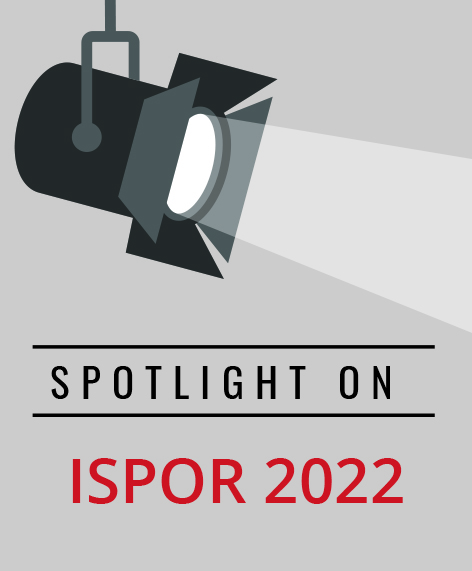Use of Real-World Evidence to Assess Comparative Effectiveness, Safety, and Medication Adherence
Tyler D. Wagner, PharmD, Virginia Commonwealth University School of Pharmacy, Richmond, VA, USA
Real-world data (RWD) is becoming increasingly important to today’s healthcare decisions, providing data outside of traditional clinical trials that is collected as a routine function of modern healthcare. RWD may come in the form of electronic health records (EHRs), insurance billing and claims databases, disease and medication registries, and patient-reported outcomes to name a few. Following analyses of RWD, real-world evidence (RWE) is generated, providing clinical evidence that supports post-marketing and new drug indication studies, while providing clinically rich insights into what happens in everyday practice (Figure).
Figure. Presenters and moderator from the session

Health economics and outcomes researchers presented a collection of RWE research in an on-demand session at ISPOR 2022 Annual Conference titled, “Real-World Evidence for Comparative Effectiveness, Safety and Adherence Evaluations.” The research spanned multiple comorbidities, examining atrial fibrillation and the risk of thromboembolic complications, the growing biologic market, oral disease modifying agents (DMAs) for multiple sclerosis, and influenza vaccinations. Laura Bozzi, PhD, MS (Janssen of Johnson & Johnson, USA) the moderator for the 4 podium presentations on RWE stated that, “despite the advantages of RWD, there is a caveat that not every dataset has every variable that we need to answer every research question.” Despite the limitations of variables that each researcher would have preferred to have for their analyses, their use of sophisticated study designs and methodologies to answer important questions has improved the available evidence at hand for decision makers.
A retrospective cohort study out of Singapore aimed to address the clinical effectiveness and safety of nonvitamin K antagonist oral anticoagulants (NOAC) in patients with non-valvular atrial fibrillation (NVAF) and to assess the long-term effect on healthcare costs once NOACs were subsidized by the ministry of health. She Hui, MS (Ministry of Health, Singapore) and colleagues found that consistent with clinical trials and other real-world published research, NOACs reduced the risk of stroke, intracerebral hemorrhage, and avoided all-cause mortality in a multi-ethnic Asian population. Ultimately, NOACs were found to be both more effective at reducing stroke and safer in regard to reducing the risk of intracerebral hemorrhage compared to warfarin. When assessing the economic implications, using NOACs instead of warfarin has the potential to bring about significant cost savings to the healthcare system through reductions of hospitalizations and its associated costs. Using a simplified Markov model, it was determined that the use of NOACs resulted in averting more than 500 deaths and a $12 million SGD savings over the 5 years since apixaban and rivaroxaban was subsidized by the ministry of health. When asked about the impact of her research, She Hui stated, “With favorable real-world data, we can be confident that the newly subsidized drugs are not worse off compared to the subsidized alternative.”
In the second presentation, Ching-Yu (Jessie) Wang, MS, PhD (Center for Drug Evaluation & Safety, USA) and colleagues assessed the real-world comparative effectiveness of pegfilgrastim biosimilars compared to pegfilgrastim originator for the prevention of febrile neutropenia in patients receiving myelosuppressive chemotherapy. Because biosimilars have demonstrated access expansion and cost savings, in addition to current RWE focusing primarily on filgrastim instead of pegfilgrastim, despite pegfilgrastim accounting for 97% of granulocyte colony-stimulating factor use, the authors conducted a retrospective cohort study assessing commercial claims data. Wang and colleagues demonstrated that the incidence of febrile neutropenia associated hospitalizations among patients with cancer undergoing chemotherapy was statistically equivalent between pegfilgrastim originator and both pegfilgrastim biosimilars, in the first cycle and across all cycles of chemotherapy. As a result, this was the first study in the United States confirming clinical equivalence using RWD by evaluating occurrence of febrile neutropenia between pegfilgrastim biosimilars and pegfilgrastim originator.
Jagadeswara Rao Earla, PhD (post-doctoral fellow at the University of Houston College of Pharmacy, USA) presented an analysis of adherence trajectories of oral disease-modifying agents (DMAs) used to prevent relapses, slow disability profession, and decrease the symptomatic burden of multiple sclerosis. Prior research had shown that oral DMAs have better adherence and adherence trajectories compared to other dosage forms, but no research had compared adherence trajectories, given that each oral DMA differs in frequency of dosing, efficacy, and toxicity profiles. Using group-based trajectory modeling, Earla and colleagues assessed longitudinal adherence patterns in a retrospective, observational study of adult patients with multiple sclerosis from a commercial claims database. The research team identified three adherence trajectory groups (ie, rapid decliners, complete adherers, and slow discontinuers) and found that patients taking fingolimod were more adherent than patients taking dimethyl fumarate or teriflunomide. Their work adds significant real-world evidence on adherence that both adjusts for clinical characteristics and is generalizable to working adults with multiple sclerosis.
The last presentation was from Monica L. Bianchini, PharmD, MPH (PhD student at the University of Colorado Anschutz School of Pharmacy, USA). Bianchini and colleagues evaluated the differences in outcomes between high- and standard-dose flu vaccines. Utilizing claims data, the researchers selected a fuzzy regression discontinuity design, a model that better accounts for the off-label use of the high-dose flu vaccine, to model the probability of the outcome of a flu or respiratory-related hospitalization. Bianchini et al found that the receipt of a high-dose flu vaccine reduced the probability of a flu or respiratory hospitalization compared to the standard-dose vaccine among adult patients 50 to 80 years old, but future research is needed to establish the most cost-effective approach to influenza vaccination among adults younger than 65.
Each presenter highlighted the advantages of answering important research questions with RWE, particularly in situations where RWD was more appropriate due to time and resource constraints. When the presenters were asked what additional dataset they would want to inform their analysis, Bianchini agreed that “linking to Medicare data would provide real robustness and the population niche that is missing now” in her current research. Wang shared that for her study, “the severity is actually the baseline for febrile neutropenia risk. Having the dosage of the chemotherapy that the patients receive and having electronic medical record data to link would be great!” Using RWD can help to ensure that patients and providers are better informed and it’s clear that these researchers are positively contributing to a growing body of high-quality RWE studies supporting multiple comorbidities.

